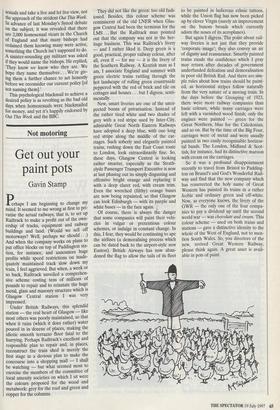Not motoring
Get out your paint pots
Gavin Stamp
Prhaps I am beginning to change my mind. It seemed to me wrong at first to pri- vatise the actual railways, that is, to set up Railtrack to make a profit out of the own- ership of tracks, equipment and railway buildings and land. (Would we sell off motorways? Well, perhaps we should ...) And when the company works on plans to put office blocks on top of Paddington sta- tion, for instance, and announces huge profits while speed restrictions on inade- quately maintained track slow down my train, I feel aggrieved. But when, a week or so back, Railtrack unveiled a comprehen- sive scheme costing tens of millions of pounds to repair and to reinstate the huge metal, glass and masonry structure which is Glasgow Central station I was very impressed. Under British Railways, this splendid station — the real heart of Glasgow — like most others was poorly maintained, so that when it rains (which it does rather) water poured in in dozens of places, making the idiotic smooth terrazzo floor fatal to the hurrying. Perhaps Railtrack's excellent and responsible plan to repair and, in places, reconstruct the train shed is merely the first stage in a devious plan to make the concourse into a shopping mall — I shall be watching — but what seemed most to exercise the members of the committee of local amenity societies on which I sit were the colours proposed for the wood and metalwork: grey for the roof and green and copper for the columns. They did not like the green: too old fash- ioned. Besides, this colour scheme was reminiscent of the old LNER when Glas- gow Central had been the terminus for the LMS ... But the Railtrack man pointed out that the company was not in the her- itage business. This was Railtrack's livery — and I rather liked it. Deep green is a good, practical, proper railway colour, after all, even if — for me — it is the livery of the Southern Railway. A Kentish man as I am, I associate England and summer with green electric trains rattling through the hot landscape of rolling green countryside peppered with the red of brick and tile on cottages and houses ... but I digress, senti- mentally.
New, smart liveries are one of the unex- pected boons of privatisation. Instead of the rather tired white and two shades of grey with a red stripe used by Inter-City, admirable Great North Eastern Railways have adopted a deep blue, with one long red stripe along the middle of the car- riages. Such soberly and elegantly painted trains, rushing down the East Coast route to London, look extraordinarily fine. So, these days, Glasgow Central is looking rather smarter, especially as the Strath- clyde Passenger Transport Executive is now at last phasing out its simply disgusting and offensive bright orange and replacing it with a deep claret red, with cream trim. Even the wretched (filthy) orange buses are now being repainted, so that Glasgow can look Edinburgh — with its purple and white buses — in the face again.
Of course, there is always the danger that some companies will paint their vehi- cles in vulgar or pretentious colour schemes, or indulge in constant change. In this, I fear, they would be continuing to ape the airlines (a demoralising process which can be dated back to the airport-style new Euston). British Airways has now aban- doned the flag to allow the tails of its fleet to be painted in ludicrous ethnic tattoos, while the Union flag has now been picked up by clever Virgin (surely an improvement on the buxom broads which currently adorn the noses of its aeroplanes).
But again I digress. The point about rail- way liveries is not just that they provide `corporate image'; they also convey an air of dignity and reassurance. Smartly painted trains exude the confidence which I pray may return after decades of government underfunded defeatism and demoralisation in poor old British Rail. And there are sim- ple rules about how trains should be paint- ed, as horizontal stripes follow naturally from the very nature of a moving train. In the days before the Grouping of 1923, there were more railway companies than basic colours, while many carriages were left with a varnished wood finish; only the engines were painted — green for the Great Northern, blue for the Caledonian, and so on. But by the time of the Big Four, carriages were of metal and were usually painted in two easily recognisable horizon- tal bands. The London, Midland & Scot- tish, for instance, had its distinctive maroon with cream on the carriages.
So it was a profound disappointment recently to travel from Bristol to Padding- ton on Brunel's and God's Wonderful Rail- way and find that the new company which has resurrected the holy name of Great Western has painted its trains in a rather feeble and ordinary green and off-white. Now, as everyone knows, the livery of the GWR — the only one of the four compa- nies to pay a dividend up until the second world war — was chocolate and cream. This colour scheme — used on both trains and stations — gave a distinctive identity to the whole of the West of England, not to men- tion South Wales. So, you directors of the new, revived Great Western Railway, please think again. A great asset is avail- able in pots of paint.


























































 Previous page
Previous page